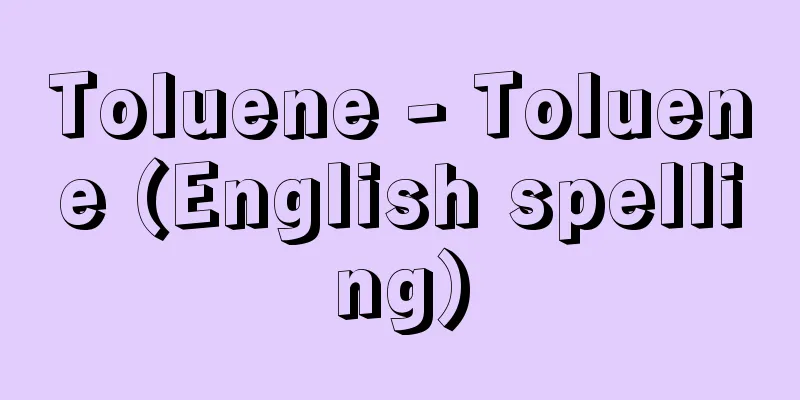Toluene - Toluene (English spelling)

|
A typical aromatic hydrocarbon. It is also called toluol or methylbenzene. It has the simplest structure among compounds that have both aliphatic and aromatic properties. A colorless, flammable liquid with a characteristic odor. It is insoluble in water. It is obtained from coal gas diesel and tar diesel. In the petrochemical industry, it is produced by catalytic reforming of petroleum fractions. In this process, methylcyclohexane, 1,2-dimethylcyclopentane, and n -heptane are converted to toluene. The methyl group -CH3 of toluene acts as an electron-donating substituent, increasing the electron density of the benzene ring and making it more susceptible to electrophilic substitution reactions. On the other hand, the benzene ring activates the reactivity of the methyl group. Toluene can be nitrated to give o- and p -nitrotoluenes, which are widely used as industrial intermediates, and these nitrotoluenes can be reduced to give o- and p -toluidines. Further nitration under strong conditions gives 2,4,6-trinitrotoluene (TNT), which is used as an explosive. In addition, the reaction with chlorosulfonic acid (chlorosulfuric acid) produces -o -toluenesulfonyl chloride, which is the raw material for saccharin. Chlorination, when carried out in the dark with iron as a catalyst, occurs at the benzene ring to produce o- and p -chlorotoluenes, which are used as solvents and as raw materials for dyes. Chlorination under light generates chlorine radicals that react with the methyl groups in the side chains to give benzyl chloride, benzal chloride, and benzotrichloride. It can be oxidized to produce benzoic acid. Under the right conditions, it can also produce benzaldehyde. These toluene derivatives are used in the manufacture of dyes, medicines, fragrances, and explosives. Disproportionation and hydrodemethylation are used to convert toluene to benzene and xylene, which have many synthetic chemical uses. Toluene itself is also used as a solvent and gasoline blending agent. Toluene vapor is toxic, so care should be taken to avoid inhaling it. [Mukai Toshio] [Supplementary Material] |Source: Shogakukan Encyclopedia Nipponica About Encyclopedia Nipponica Information | Legend |
|
代表的な芳香族炭化水素の一つ。トルオール、メチルベンゼンともいう。脂肪族と芳香族の性質をもつ化合物のなかで、もっとも簡単な構造である。 特異なにおいをもつ無色の可燃性の液体。水に不溶。石炭のガス軽油やタール軽油から得られる。石油化学工業では石油留分の接触リホーミングにより製造する。この方法では、メチルシクロヘキサン、1,2-ジメチルシクロペンタン、n-ヘプタンがトルエンに変化する。 トルエンのメチル基-CH3は、電子供与性の置換基としてベンゼン環の電子密度を増加させ、求電子置換反応をおこりやすくする。他方、ベンゼン環はメチル基の反応性を活性化する。トルエンは、ニトロ化により工業的中間体として広く利用されるo(オルト)-およびp(パラ)-ニトロトルエンを与え、これらのニトロトルエンの還元によりo-およびp-トルイジンが得られる。さらに強い条件下でニトロ化すると、爆薬として用いられる2,4,6-トリニトロトルエン(TNT)が得られる。また、クロロスルホン酸(クロロ硫酸)を作用させるとサッカリンの原料となる塩化-o-トルエンスルホニルを生成する。 塩素化は、鉄を触媒として暗所で行うとベンゼン環におこり、o-およびp-クロロトルエンを生成する。これらは溶剤として使われ、染料の原料となる。光照射下で塩素化を行うと、塩素ラジカルが発生し側鎖のメチル基と反応して、塩化ベンジル、塩化ベンザル、ベンゾトリクロリドが得られる。 酸化により安息香酸を生成する。適度な条件下ではベンズアルデヒドを得ることもできる。これらのトルエン誘導体は、染料、医薬、香料、爆薬などの製造に用いられる。トルエンを合成化学的用途の多いベンゼンやキシレンに変えるためには、不均化法や水素化脱メチル反応などが用いられる。また、トルエンそのものは溶剤やガソリン配合剤としての用途がある。トルエンの蒸気は中毒性があるので、吸入しないような注意が必要である。 [向井利夫] [補完資料] |出典 小学館 日本大百科全書(ニッポニカ)日本大百科全書(ニッポニカ)について 情報 | 凡例 |
<<: Toluenesulfonic Acid - Toluenesulfonane
>>: Druid - Druid (English spelling)
Recommend
Circular fence - Kanjodori
Please see the "Dining Tombs" page. Sou...
Henry Draper
American astronomer and founder of astrophotograp...
Address - 1st floor
It refers to the main place of residence of each ...
Nakamura Teijo
Haiku poet. Born in Kumamoto City. Maiden name: S...
Rig Veda (English spelling)
One of the four Vedas, the holy books of ancient I...
Awaseuchi - Awaseuchi
...Except for Shiki Sanban (Okina), each piece is...
Kadokurazaki
A cape at the southern tip of Tanegashima Island i...
Sencho [town] - Sencho
An old town in Yatsushiro County, Kumamoto Prefect...
Fawcett, Henry
Born: 26 August 1833, Salisbury, Wiltshire [Died] ...
The rockfish of the seashore is all talk - The rockfish of the seashore is all talk
… It is an ideal target for rock fishing and is r...
Medical Social Worker
...The former refers to social welfare, social se...
Browse
The eyebrows are the group of hairs that grow den...
Flower Signal Wind
(1) The wind that signals the opening of flowers ...
Giant fruit fly - Giant fruit fly
...This is called the coffin fly, Conicera tibial...
NW - New York
《 Network Specialist Examination 》⇒Network Special...









